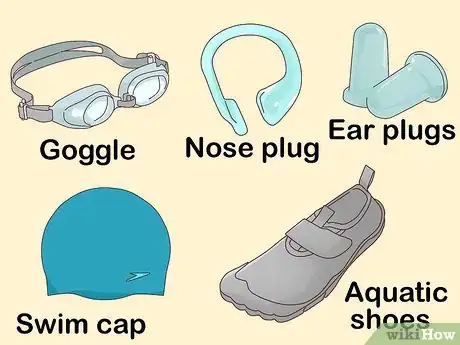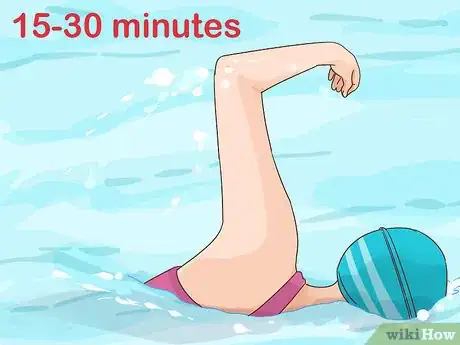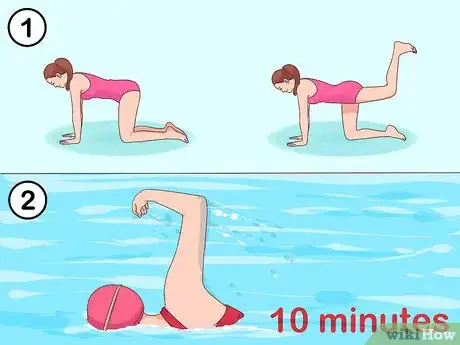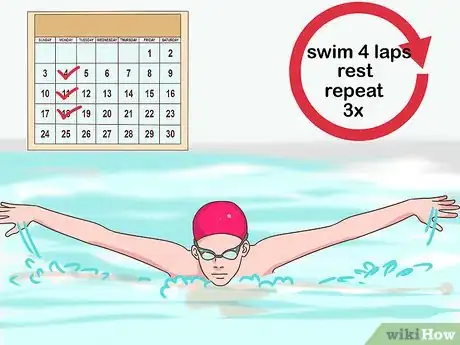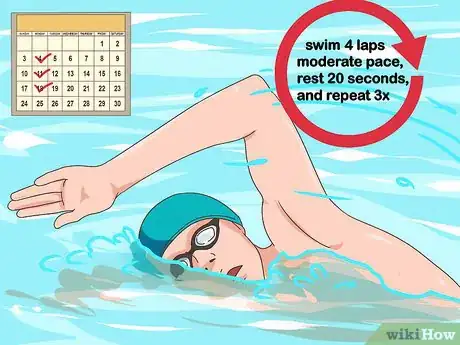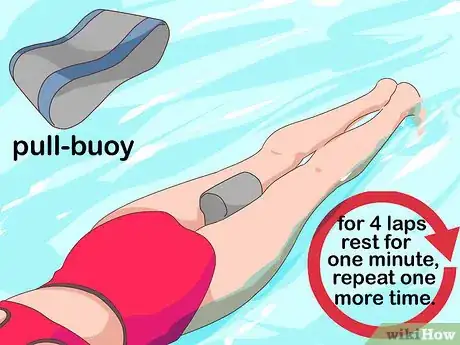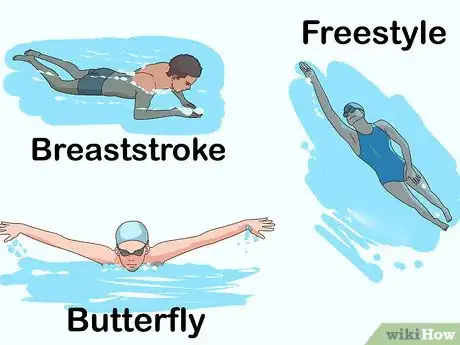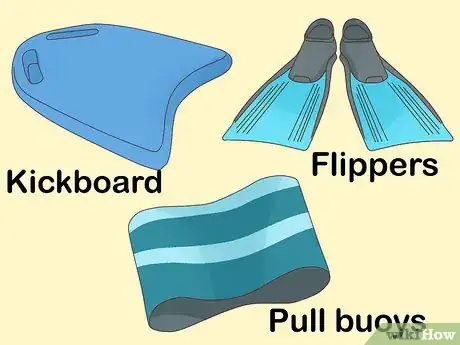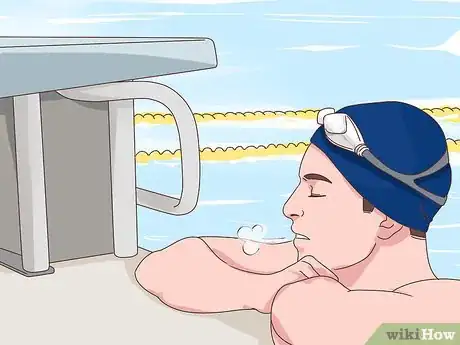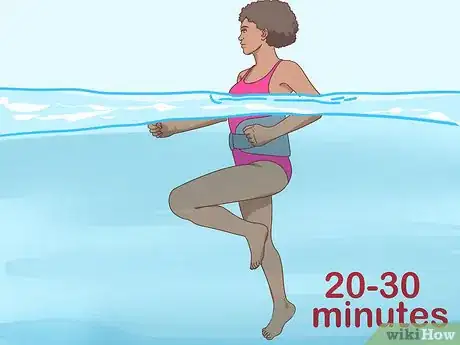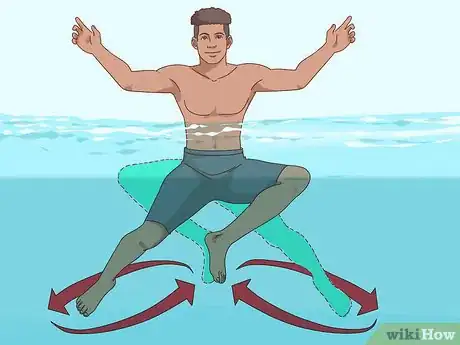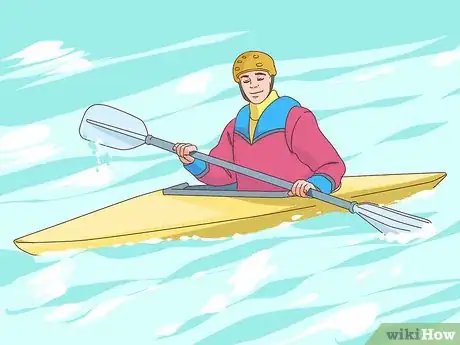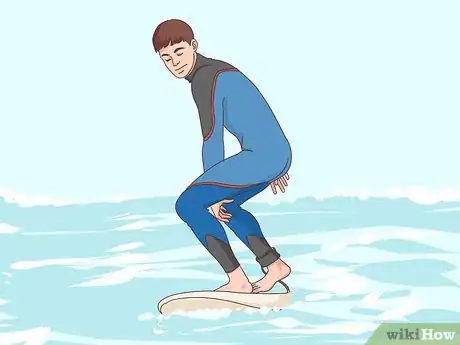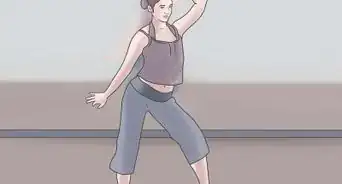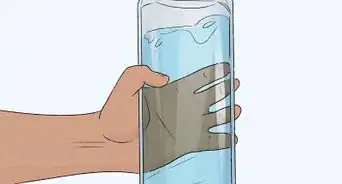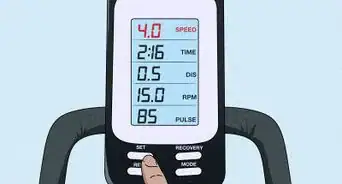This article was co-authored by Michele Dolan. Michele Dolan is a BCRPA certified Personal Trainer in British Columbia. She has been a personal trainer and fitness instructor since 2002.
There are 11 references cited in this article, which can be found at the bottom of the page.
This article has been viewed 37,075 times.
Water exercise is a fun way to boost your cardiovascular health and strength. It's also a great way to work on flexibility. The water's buoyancy and resistance, which is twelve times greater than air, allow you to exercise in a no-impact environment. A water exercise routine several days per week can be an excellent form of exercise for individuals who have back pain, arthritis, diabetes, obesity and injuries to the lower body. You can exercise in water by swimming laps or doing water resistance activities.
Steps
Swimming Laps
-
1Gather swimming gear. Look around your home for any swimming gear that you may have. Try on your swimsuit(s) and make sure it fits comfortably and allows you to move easily through the water without sliding off. See if you have other items such as ear plugs or goggles to make your swim more comfortable. Use or buy these for your swimming sessions if you like. Some accessories to consider include:
- Goggles
- A swim cap
- Ear plugs
- A nose plug
- Aquatic shoes
-
2Take swimming lessons. Have a professional give you a refresher on how to perform different strokes. Take a swimming class with an instructor if you don't know how to swim or feel uncomfortable in the water. Taking private or class swimming lessons can ensure you use proper swimming form and gain optimal cardio and strength results.
- Look for classes at a local recreational center, pool, or health club. Ask your swim instructor to teach several different strokes using proper techniques.
Advertisement -
3Pace yourself. Build up your swimming fitness by starting with 15-30 minutes of swimming 3 to 5 days a week at an easy to moderate stroke speed for you. Gradually increase your overall time and stroke speed as you get stronger and have better endurance. Giving yourself time to build up water fitness can minimize your risk of injury or overdoing it.[1]
-
4Warm up your body. Perform light moves like arm, wrist, and ankle circles, leg lifts, calf raises, and donkey kicks either before or after you've slipped into the water. Then, warm up by swimming at a slow pace for about 10 more minutes. Warming up gives your body a chance to get used to movement and can minimize your risk of injury.[2] Some different examples of how to mix up a warm up include:[3]
- 4 laps swimming, 2 laps kicking, 1 lap pulling, 1 lap swimming. You'll need a kickboard for kicking laps (i.e. just using your lower body) and a “pull buoy” for pulling laps (i.e. just using your upper body).
- 20 lap swim, or any distance of your choice
- 10-15 minutes of anything you feel like doing in the pool
-
5Incorporate one speed workout per week. After your warm up, start your main set, which will really train your cardiovascular system and muscles. Once a week, include speed sets and drills. Try any of the following as a part of your speed workout:[4]
- Swim 4 laps, rest, and then repeat 3 more times
- Swim 1 lap at maximum effort, rest for 30 seconds and repeat 9 more times
- Swim 8 laps with decreasing stroke speed, swim 4 laps at your easy pace, and repeat one more time
-
6Do one distance workout each week. Focus one of your swim workouts on building endurance. This can help develop your muscles and cardiovascular system. It may also improve your speed. Consider any of the following endurance sets or create one yourself:[5]
- Swim 4 laps at a moderate pace, rest 20 seconds, and repeat 3 more times
- Swim 6 laps at a moderate pace focusing on proper technique, rest for 2 minutes, and repeat one more time
- Swim 10 laps at an easy to moderate pace, rest for 2 minutes, and repeat three more times
-
7Work your technique and strength with drills. Focus one additional day on developing your technique and strength. Swim with props such as pull buoys or kickboards. Drills help develop your stroke technique and build muscle. They can even improve your speed and endurance. Try the following technique workouts:[6]
- Use a pull-buoy for 4 laps, rest for one minute and repeat one more time
- Swim 4 laps with one arm and then repeat on the other arm
- Swim 4 laps breathing on one side of your body, rest, swim 4 laps breathing on the other side, rest, and then swim 4 laps alternating breaths on each side of your body
-
8Vary your strokes. Mix up your workouts by doing different strokes for each lap or every few laps. Incorporating these different body movements works different muscle groups, increases your endurance and helps you get a better feel for the water. Use any of the following strokes during your warm up, main set, and cool down:[7]
- Backstroke
- Breaststroke
- Freestyle
- Butterfly
- Side stroke
-
9Build strength and technique with training aids. Try out different gadgets that your local pool has available to anyone to enhance your training. Using training aids such as pull buoys or flippers can build targeted strength and improve stroke technique. The different types of training aids you can use while swimming include:[8]
- Kickboards
- Flippers
- Pull buoys
- Resistance gloves
- Hand paddles
-
10Cool down your body. Swim for a few minutes or laps after you've finished your main set. Cooling down and gradually slowing the heart rate can help prevent blood from pooling in any one part of the body. This may help improve how your muscles feel after exercise. Remember to do as many laps as you are able to start, adding more as you get stronger.[9]
Doing Water Resistance Activities
-
1Join a water fitness class. Ask your local pool, recreation center, or gym if they offer group water fitness classes. Try different types of classes that use the water's resistance to build your strength and endurance. Participating with other people in water fitness classes can make exercising in water more fun and keep you motivated. Some of the water fitness classes you can join include:
- Water aerobics
- Aqua zumba[10]
- Aqua barre
- Aqua yoga
-
2Walk through water. Purchase or borrow a flotation belt, which will allow you to keep your head above water. Put on your belt and gently slide into either end of the pool. Deeper water puts less impact on your joints and muscles and also allows a greater range of motion. Stand straight with your shoulders back and chest lifted and then stride forward for as many steps as you like. Keep your abs and core muscles engaged to maintain your stability.[11]
- Mix up your walking routine with any of the following types of steps: marching steps, gliding sideways, or walking backwards.
- Add weighted water gloves or webbed gloves for arm-strengthening moves.[12]
-
3Go for a run. Strap on a flotation belt or hold water weights or a pool noodle to keep you afloat. Lean slightly forward with your upper body straight and chest lifted. Then bring up one knee to a 90-degree angle and push it down through the water with the same foot. Calculate your workout in time, not in miles. Aim for 20-30 minutes when you first start and gradually increase your time as you get fitter.[13]
-
4Tread water. Hop into water that is about chest to shoulder deep. Release your feet from the bottom and kick your legs in a beater-type motion. At the same time, cup your hands and scull them back and forth in the water. Perform these as quickly as you can for 30-60 seconds and then rest for 30 seconds. Repeat the exercise as many times as you like.[14]
- Hold light weights while treading water for an added strength boost and calorie burn.
- Tread water at a slower pace for an extended period of time to build endurance.
-
5Paddle on a watercraft. You don't always have to be in the water to get the benefits of water exercise. Instead, use different types of watercraft you have to operate and steer with paddles. Doing this can build endurance, but also strengthen your abs, core, back, and arms. Try the following paddle-driving activities for exercise and fun:[15]
- Kayaking
- Canoeing
- Stand-up paddleboarding
-
6Ride on the water's surface. Much like water sports with paddling, other activities allow you to exercise in water without getting in it. Use the surface of the water to help you get a little exercise and build strength throughout your body as well as endurance. Sports that let you skim or ride the surface of the water for exercise include:[16]
- Surfing
- Waterskiing
- Wakeboarding
Expert Q&A
-
QuestionCan you lose weight with water aerobics?
 Michele DolanMichele Dolan is a BCRPA certified Personal Trainer in British Columbia. She has been a personal trainer and fitness instructor since 2002.
Michele DolanMichele Dolan is a BCRPA certified Personal Trainer in British Columbia. She has been a personal trainer and fitness instructor since 2002.
Certified Fitness Trainer Water aerobics burns fewer calories than land aerobics, so be sure to reduce calorie intake to lose weight when relying on water aerobics.
Water aerobics burns fewer calories than land aerobics, so be sure to reduce calorie intake to lose weight when relying on water aerobics. -
QuestionWhat are some water exercises?
 Michele DolanMichele Dolan is a BCRPA certified Personal Trainer in British Columbia. She has been a personal trainer and fitness instructor since 2002.
Michele DolanMichele Dolan is a BCRPA certified Personal Trainer in British Columbia. She has been a personal trainer and fitness instructor since 2002.
Certified Fitness Trainer A few popular options include water jogging, swimming, all kinds of arm paddling, jumping and diving.
A few popular options include water jogging, swimming, all kinds of arm paddling, jumping and diving. -
QuestionCan you lose weight by walking in a pool?
 Michele DolanMichele Dolan is a BCRPA certified Personal Trainer in British Columbia. She has been a personal trainer and fitness instructor since 2002.
Michele DolanMichele Dolan is a BCRPA certified Personal Trainer in British Columbia. She has been a personal trainer and fitness instructor since 2002.
Certified Fitness Trainer Yes, but it is harder to get the heart rate as high and burn as many calories as you do on land.
Yes, but it is harder to get the heart rate as high and burn as many calories as you do on land.
Warnings
- Speak to your doctor before doing any exercises in water. They can let you know if you are healthy enough for aquatic fitness. The doctor can advise you on swimming strokes that you should avoid, or equipment that might be useful.⧼thumbs_response⧽
- Recognize that the quality of stroke technique may decrease a bit if you get tired. Having distance or speed laps where you focus your attention on technique can remind your arms and legs of what they should be doing.⧼thumbs_response⧽
Things You'll Need
- Swimsuit
- Towel
- Pool shoes, flip flops, or aquatic shoes
- Swim cap
- Swimming goggles
- Swimming belt
- Water weights
- Resistance gloves
- Sunscreen
References
- ↑ http://www.mayoclinic.org/healthy-lifestyle/fitness/expert-answers/exercise/faq-20057916
- ↑ http://www.nsmi.org.uk/articles/injury-prevention/warming-up.html
- ↑ https://breakingmuscle.com/fitness/a-beginner-s-guide-to-structuring-your-swim-workout
- ↑ https://breakingmuscle.com/fitness/a-beginner-s-guide-to-structuring-your-swim-workout
- ↑ https://breakingmuscle.com/fitness/a-beginner-s-guide-to-structuring-your-swim-workout
- ↑ https://breakingmuscle.com/fitness/a-beginner-s-guide-to-structuring-your-swim-workout
- ↑ http://www.triathlete.com/2017/04/training/one-hour-workout-mixed-strokes-swim-session_112750
- ↑ https://www.swimmingworldmagazine.com/news/swimming-fast/
- ↑ https://breakingmuscle.com/fitness/a-beginner-s-guide-to-structuring-your-swim-workout
- ↑ http://www.syracuse.ymca.org/programshealthy-livingfitnessadult-aquaticsaquatic-fitness-classes.html
- ↑ http://www.arthritis.org/living-with-arthritis/exercise/workouts/simple-routines/water-walking.php
- ↑ http://www.mayoclinic.org/healthy-lifestyle/fitness/multimedia/aquatic-exercise/sls-20076730
- ↑ http://www.runnersworld.com/run-matters/aqua-jogging-lessons-learned
- ↑ http://www.fitnessmagazine.com/workout/lose-weight/total-body/pool-workout/?page=0
- ↑ http://www.mensfitness.com/get-fit/top-5-water-activities-for-burning-calories
- ↑ http://www.mensfitness.com/get-fit/top-5-water-activities-for-burning-calories
